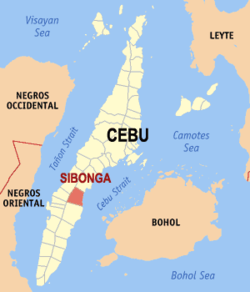Sibonga | |
|---|---|
| Municipality of Sibonga | |
 Sibonga Municipal Hall | |
| Anthem: Sibonga hymn | |
 Map of Cebu with Sibonga highlighted | |
 Interactive map of Sibonga | |
Location within the Philippines | |
| Coordinates: 10°02′N123°34′E / 10.03°N 123.57°E | |
| Country | Philippines |
| Region | Central Visayas |
| Province | Cebu |
| District | 1st district |
| Barangays | 25 (see Barangays) |
| Government | |
| • Type | Sangguniang Bayan |
| • Mayor | Caroline Bacaltos (NP) |
| • Vice Mayor | Mariano Laude (NP) |
| • Representative | Rhea Mae A. Gullas |
| • Municipal Council | Members |
| • Electorate | 34,444 voters (2025) |
| Area | |
• Total | 133.45 km2 (51.53 sq mi) |
| Elevation | 79 m (259 ft) |
| Highest elevation | 666 m (2,185 ft) |
| Lowest elevation | 0 m (0 ft) |
| Population (2024 census) [3] | |
• Total | 54,610 |
| • Density | 409.2/km2 (1,060/sq mi) |
| • Households | 12,457 |
| Economy | |
| • Income class | 1st municipal income class |
| • Poverty incidence | 40.62 |
| • Revenue | ₱ 185.8 million (2021) |
| • Assets | ₱ 841.1 million (2021) |
| • Expenditure | ₱ 133.9 million (2021) |
| • Liabilities | ₱ 260.7 million (2021) |
| Service provider | |
| • Electricity | Cebu 1 Electric Cooperative (CEBECO 1) |
| Time zone | UTC+8 (PST) |
| ZIP code | 6020 |
| PSGC | |
| IDD : area code | +63 (0)32 |
| Native languages | Cebuano Tagalog |
Sibonga, officially the Municipality of Sibonga (Cebuano : Lungsod sa Sibonga; Tagalog : Bayan ng Sibonga), is a municipality in the province of Cebu, Philippines. According to the 2020 census, it has a population of 53,424 people. [5]



